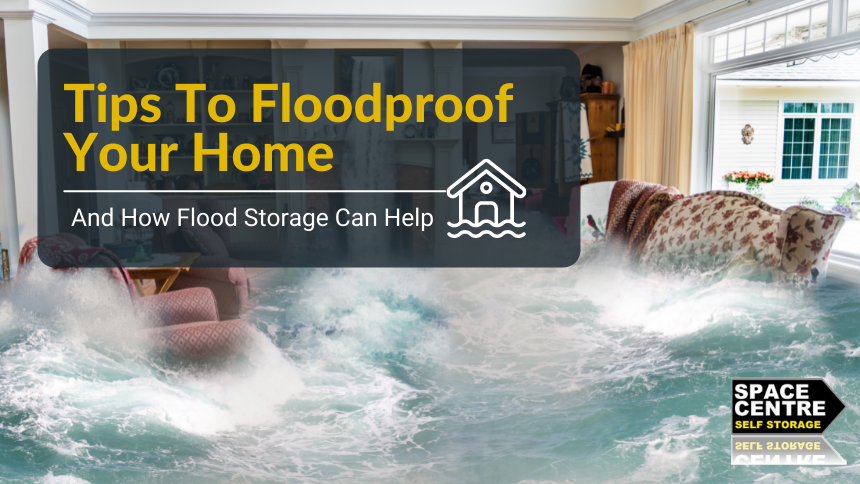With the colder, wetter weather fast approaching, flooding is once again a real concern. Aside from your own safety, your belongings and property are also of significance. It is always wise to implement one or two plans beforehand – just in case. With that comes flood storage which refers to a designated safe place at your local self storage facility if necessary.
Whether you want to declutter your home or office, find a storage base in winter for your garden tools or a safe, damp-free space for your belongings when the weather threatens your property, flood storage is a cheap, short-term, worry-free solution. In this article, we highlight the importance of flood-proofing your home and how self storage can help.
How Flood Storage Can Help
Victims of flooding are often left temporarily homeless with tens of thousands in damages. Just think of the floods particularly in 2013 and 2020 with Storm Francis. Whilst insurance offers relief and peace of mind, it’s still a huge inconvenience so it’s only normal to have genuine fears that you might suffer flood damage again. However, by planning for the worst-case scenario, you can floodproof your home in advance and use flood storage.
Recommended: Self Storage Insurance: What You Need To Know
How To Flood-Proof Your Home
While it’s nearly impossible to completely flood-proof a property, there are several things you can do to help reduce the impact it can have. To control the flow of floodwater away from your home, consider stocking up on sandbags, flood bags or flood barriers. Make sure everyone in the household knows where they are stored and how to use them most effectively.
Creating Flood Barriers At Home
Sandbags are made from woven hessian to absorb moisture and stop water from getting through. People use it to weigh down manhole covers and garden furniture, block sinks, toilets and bath drains so flood water can’t stream in.
Flood bags use crystals instead of sand to absorb water and are easier to move and store than sandbags. Flood bags fill up quickly and expand to create a barrier with the ability to store water for a few months. However, you can only use them once so don’t test them beforehand.
Flood barriers (or pods) interconnect collecting and storing rising floodwater to create a dense barrier. Each pod has a foam gasket base that creates a seal with the ground from the weight of the water which means you don’t need to bolt anything in place.
You can also create 90-degree angles to build watertight corners. And, when the flood water recedes the pods are automatically emptied and become light enough to moved and stack.
Air Brick Covers For Flooding
Flood water can quickly enter your home through windows and doors but don’t forget about air bricks. Without using air brick covers, water can easily get in and invade your home. Be better prepared by temporarily sealing your air bricks with a cover which are available in singles or doubles. They usually include all the fitting you’ll need for a quick installation and removal.
Reinforce External Doors
If you don’t think you need flood storage and prefer a more permanent solution, you should consider fitting a flood door panel to external doors. These panels can be quickly and easily installed to provide a good seal in the event of an emergency. Although the flood door panel is a permanent fixture, you can give it a coat of paint to match your home.
Protecting Pets During Flooding
Animals are also in great danger when it comes to flooding especially since you may not be at home when a flood hits. It’s important to speak with your neighbours or friends that live in the area and ask them to help in case of an emergency. Make sure to provide them with all of your contact information and perhaps a key that they can easily gain access to your pets if necessary.
Keep pet carriers or boxes somewhere that is accessible and remember to have a bag of pet essentials nearby. This will help you or your neighbour/friend quickly evacuate your pets and minimise risk in case of a flood.
If you have rabbits, chickens or any other animals living outside, raise their hutches or coops as safely as possible and make sure to secure it to the ground. This will protect your animals from the flood water and stop the structure from toppling over.
Flood Preparation And Flood Storage
If you are in an area prone to flooding, here are some additional measures you can take to protect your property from damage whether it’s minor or more serious.
Flood Storage With Space Centre
If you live in an area that has or could be affected by flooding, a safe flood storage unit should be your first choice. When someone needs to transfer their ground-floor furniture and other belongings, our storage facilities in Bristol, Stroud, Gloucester and Stonehouse can provide a safe haven.
By using flood storage, you can rest assured knowing your goods will be kept in a secure, damp-free unit until the difficult times are over. These flood storage units have the space you need to store valuable items that you don’t want to leave in the house or cannot go upstairs. Give us a call to find out how much a flood storage unit would cost if you are hit by storms this winter or visit our website today.
At Space Centre Self Storage, “we have always urged people to come and speak with us and discuss the option of self storage during times of possible flood damage. We don’t insist on long-term contracts and we have many units of all shapes and sizes”.
